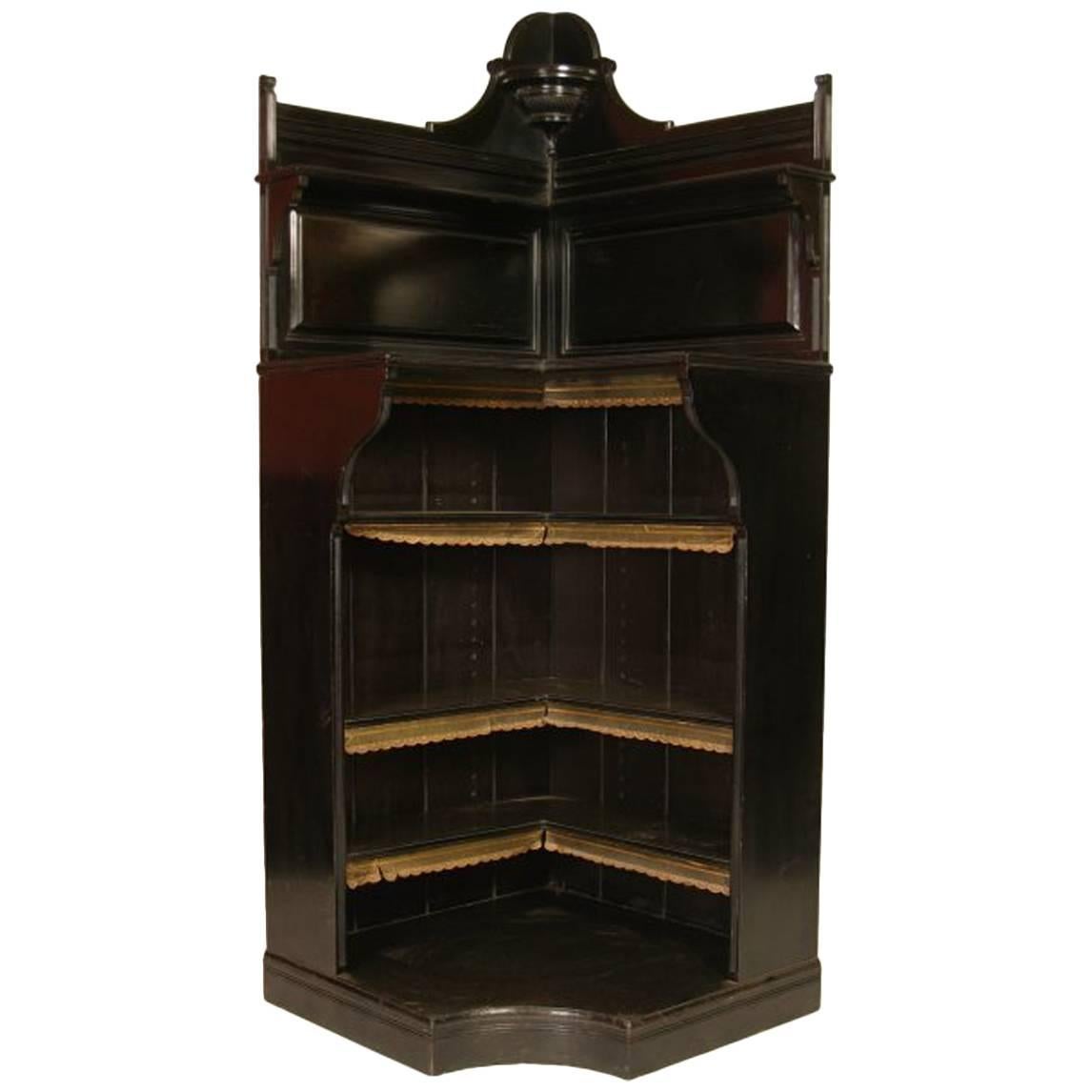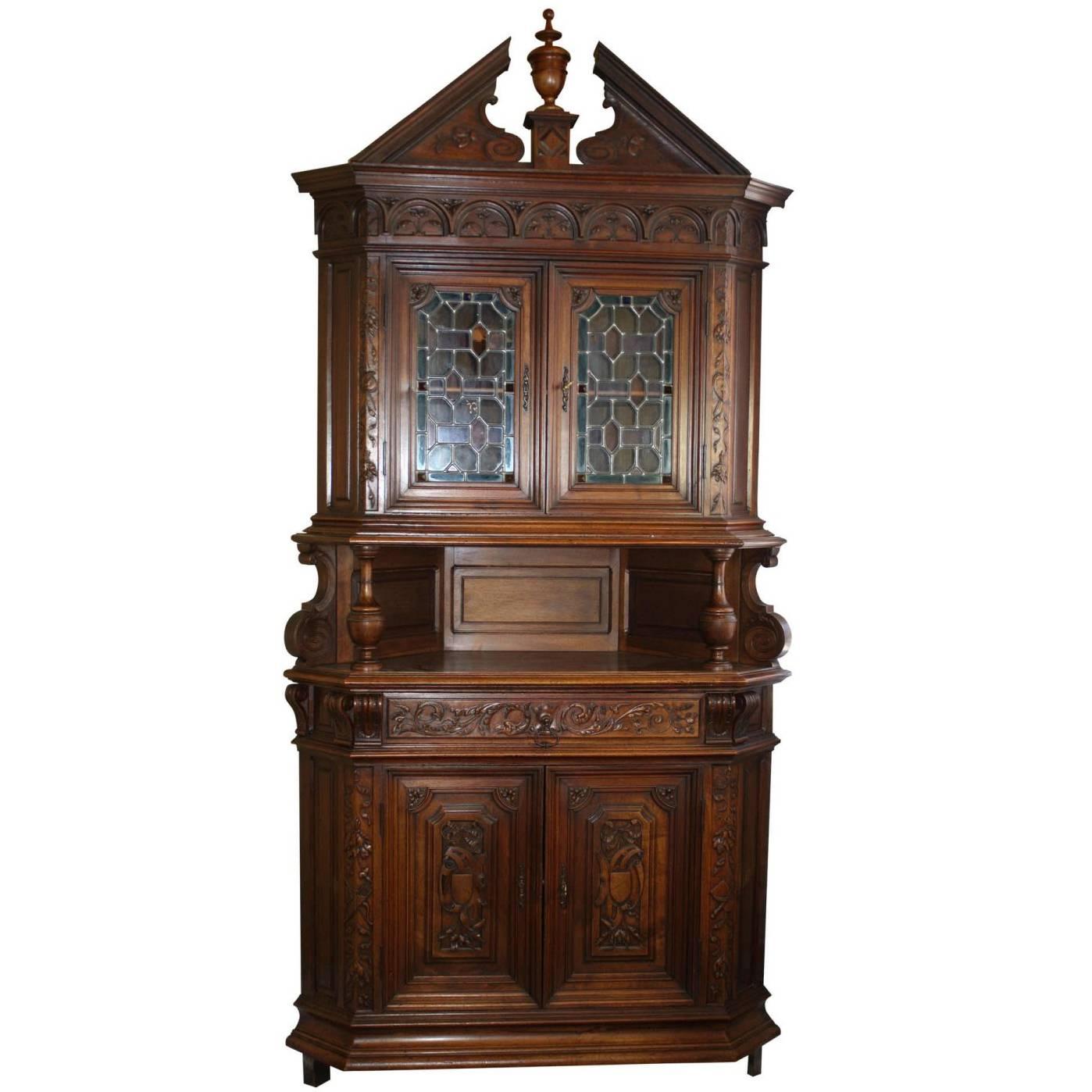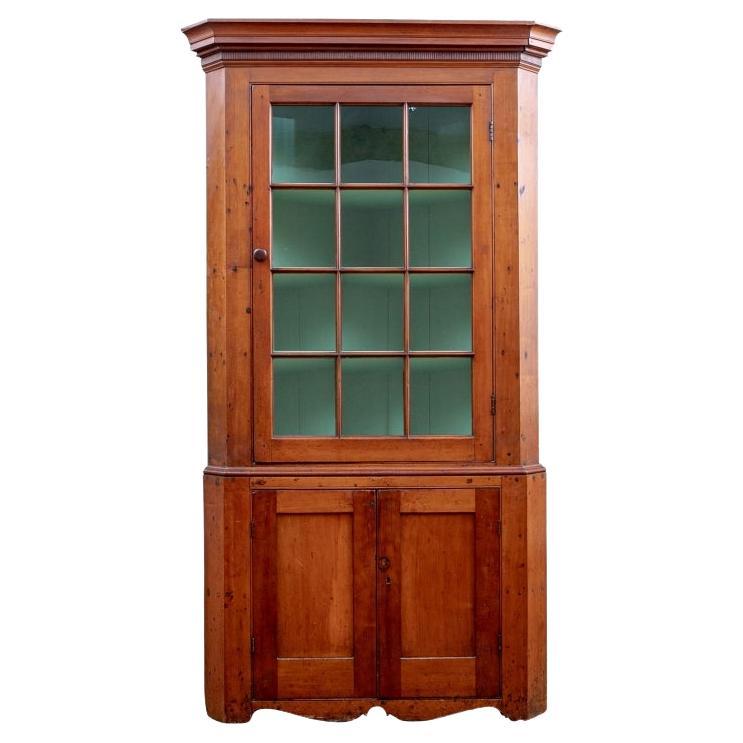Items Similar to Stephen Webb for Collinson & Lock, a Renaissance Revival Inlaid Corner Cabinet
Want more images or videos?
Request additional images or videos from the seller
1 of 15
Stephen Webb for Collinson & Lock, a Renaissance Revival Inlaid Corner Cabinet
About the Item
Stephen Webb for Collinson & Lock of London.
An outstanding exhibition quality satinwood and marquetry Renaissance Revival inlaid corner cabinet of the style exhibited at the London International Exhibition in 1871, America and Vienna and at the Paris 1878 Exhibition.
The glazed top section with original red velvet lining.
Illustrated in the Collinson & Lock catalogue.
Collinson and Lock of London 'Art Furnishers', founded with the partnership of F.G. Collinson and G.J. Lock, former employees of Jackson and Graham. Designers employed by the firm included T.E. Collcutt, the architect of their premises; E.W. Godwin, who was paid a retainer to produce exclusive designs for the company from 1872 to 1874, H.W. Batley and Stephen Webb. They made furniture for the new Law Courts to designs by G.E. Street, along with Gillows and Holland and Sons, and began decoration of the Savoy Theatre in 1881. Jackson and Graham was taken over in 1885, at the time when the firm had moved to Oxford Street and begun to focus on expensive commissions for grandiose London houses. The firm was taken over by Gillows in 1897. The firm of Collinson and Lock was established in London in the third quarter of the 19th century and quickly achieved both commercial success and a leading position in the field of design. In 1871 the firm issued an impressive illustrated catalogue of 'Artistic furniture', with plates by J. Moyar Smith, assistant to Christopher Dresser, and in 1873 was trading from extensive newly built premises in St Bride Street. The firm continued to produce very high quality items of furniture and soon began to experiment with new materials and designs, becoming especially renowned for their distinctive combinations of rosewood and ivory and their intricate Italianate arabesques, traditional figures and scrolling foliage. This form of decoration clearly points toward the involvement of Stephen Webb, Collinson and Locks chief designer who was later appointed Professor of Sculpture at the Royal College of Art.
- Creator:Collinson & Lock (Cabinetmaker)
- Dimensions:Height: 77.57 in (197.03 cm)Width: 43 in (109.22 cm)Depth: 23 in (58.42 cm)
- Style:Renaissance Revival (Of the Period)
- Materials and Techniques:
- Place of Origin:
- Period:
- Date of Manufacture:1870
- Condition:Wear consistent with age and use.
- Seller Location:London, GB
- Reference Number:1stDibs: LU2243310574133
About the Seller
5.0
Vetted Seller
These experienced sellers undergo a comprehensive evaluation by our team of in-house experts.
Established in 1989
1stDibs seller since 2016
235 sales on 1stDibs
Typical response time: <1 hour
- ShippingRetrieving quote...Ships From: London, United Kingdom
- Return PolicyA return for this item may be initiated within 3 days of delivery.
More From This SellerView All
- Ebonized Open Corner Cabinet, Attributed to Collinson and LockBy Collinson & LockLocated in London, GBAn ebonized open corner cabinet. Attributed to Collinson and lock. Measures: Height 69 1/2", width at front 31", depth at back ...Category
Antique 19th Century Corner Cupboards
- Stephen Webb for Collinson & Lock Attr. Late Victorian Inlaid Mahogany ArmchairBy Collinson & LockLocated in London, GBStephen Webb for Collinson & Lock of London, attributed. A good quality English Renaissance Revival finely inlaid Mahogany button back uph...Category
Antique 1870s English Late Victorian Lounge Chairs
MaterialsMahogany
- Collinson & Lock. Aesthetic Movement Anglo-Japanese Glazed Walnut Side CabinetBy Collinson & LockLocated in London, GBCollinson & Lock. An outstanding quality Aesthetic Movement Anglo-Japanese walnut side cabinet with dentil moulding to the cornice and astr...Category
Antique Late 19th Century English Aesthetic Movement Cabinets
MaterialsWalnut
- E W Godwin made by Collinson & Lock of London. Eaton Hall Rosewood China CabinetBy Edward William GodwinLocated in London, GBEdward William Godwin (1833-1886) for Collinson and Lock, The Eaton Hall cabinet, circa 1878, in rosewood, the scroll-carved broken arched Queen Anne pediment above a dentil and moulded frieze, with a pair of astragal glazed doors flanked by shelves beneath fielded panels, above a central drawer and semi-circular cupboards, the moulded top above a pair of panelled doors with an open panelled section beneath, on shaped splayed feet, japanesque engraved brass handles, hinges and lockplates, stamped 'Collinson and Lock, London 7480', the handles, hinges and lockplates all stamped 'Elsleys, Gt Portland St, London'. Provenance: Eaton Hall, Cheshire. A previous owner purchased this lot from a sale of the contents at Sweetenhams of Chester, 20th and 21st May 1959, where it states:- '283. Rosewood display cabinet, the upper portion enclosed with astragal glazed doors with side shelves, the lower portion enclosed with two panelled doors. This was the last mention of the Rosewood cabinet before it was sold. This piece has many features, which firmly show Godwin's hand at work, i.e. Queen Anne broken pediment, (Soros, Susan Weber 'The Secular Furniture of E.W. Godwin', Butterfly cabinet, p. 227; and a Queen Anne cabinet p. 269 and an 'over door', p. 251), the dentil moulding to the top is identical to the Butterfly cabinet, the astragal glazed doors and panelled lower doors identical to a design for a table for Grey Towers (Susan Soros, 'Secular Furniture', p. 157 and similar detail to the doors on two cabinets on pp. 222-223). The semi-circular central side doors and semi-circular open shelves above are identical to a dressing table and a sketch for a dresser (Susan Soros, 'Secular Furniture', p. 211), a design for a mantelpiece (Susan Soros, 'Secular Furniture', p. 248) and a design for a buffet (Susan Soros, 'Secular Furniture', p. 265). The integrated design of solids and voids in many of his cabinet designs and the framed back panels to each individual shelf and framed panels to each side is typical of his work. The splayed front feet are identical to the Four Seasons cabinet (Susan Soros, 'Secular Furniture', p. 217). The elongated handles with japanesque engraved backplates simulate Japanese woven rush work (Susan Soros, 'E.W. Godwin Aesthetic Movement, Architect and Designer', p. 303, fig. 11-10 and Susan Soros, 'Secular Furniture', p. 268) a detail he used in many combinations. 'Sheraton and Queen Anne in Japan at Eaton Hall' only Godwin could have designed this exceptional work of art. Possibly part of a larger commission, the Eaton Hall archivist also found a Collinson and Lock billiard table in the inventory at Eaton Hall. Godwin is known to have designed billiard tables for Collinson and Lock, a design appears in his sketchbook on the 6th of October 1873, carved in the Jacobean style with circular decorations of white storks in relief interspersed with square panels. A corresponding entry on the 7th of October 1873 it shows that he designed it for the McLaren house, a large commission that Godwin did at Adison Rd, Kensington. The third Marquis of Westminster, who later became the 2nd Duke of Westminster, commissioned Sir Alfred Waterhouse to substantially remodel and rebuild Eaton Hall. The work began in 1869 and reached its completion in 1883. The large drawing room can be seen in a photograph taken, circa 1887, pl. 199 in Cooper, Jeremy. Victorian and Edwardian Furniture and Interiors, in which Cooper mentions that the Duke had spent 600,000 pounds on the decoration alone and that Heaton, Butler and Bayne carried out the work. In 1885, an inventory of the contents of Eaton Hall was carried out, and it is precisely at this point in time that the cabinet receives its first mention. Having occupied a place in the Ormand Sitting Room, 72 on the ground floor of the North Wing of the Waterhouse Hall, the cabinet was described as, 'A Rosewood china cabinet with cupboards beneath and glass fronts at the top, 50ins'. The cabinet is then mentioned again in a 1917 inventory in the Angel Bedroom. The cabinet made its next appearance in 1931 in the 'Declaration of Trusts', which was a valuation of the contents of Eaton Hall, appearing as T86/27 in the Stewards Offices with a similar description, and then finally in the 1959 sale catalogue mentioned above. Sotheby's and various other local auctioneers held many sales of the various contents of Eaton Hall from 1955 through to 1961 until the Hall was demolished in 1961. This description was compiled with the generous help and assistance of the Grosvenor Estate's Archive Department, Eaton Hall, Cheshire. Collinson and Lock of London...Category
Antique Late 19th Century English Anglo-Japanese Cabinets
MaterialsRosewood
- E W Godwin, Collinson & Lock, an Anglo Japanese Mahogany and Satinwood CabinetBy Edward William Godwin, Collinson & LockLocated in London, GBEdward William Godwin. Made by Collinson & Lock. A fine quality Anglo Japanese mahogany and astragal glazed cabinet with satinwood line inlay. ...Category
Antique 1870s English Anglo-Japanese Cabinets
MaterialsMahogany, Satinwood
- Collinson & Lock an English Aesthetic Movement Mahogany Glazed Wall CabinetBy Collinson & LockLocated in London, GBCollinson and Lock London. 103. Stamped to the back. An English Aesthetic Movement Mahogany glazed wall cabinet with incised scrollwork sw...Category
Antique 1880s English Aesthetic Movement Shelves and Wall Cabinets
MaterialsGlass, Mahogany
You May Also Like
- 19C English Marquetry Inlaid Corner Cabinet Attributed to Collinson and LockBy Collinson & LockLocated in Dallas, TXPRESENTING A GORGEOUS late 19th Century British made corner cabinet, made of beautiful rosewood and profusely inlaid with marquetry and faux ivory. Made in London, by Collinson and ...Category
Antique Late 19th Century English High Victorian Corner Cupboards
MaterialsBone, Ebony, Rosewood, Satinwood
- French Walnut Renaissance Revival Corner Cabinet, circa 1875Located in Evergreen, COLeaded glass doors accented with blue, red, and gold stained glass are featured on this walnut corner cabinet. The relief carvings of foliage, flowers, and crests, which are masterfu...Category
Antique Late 19th Century French Renaissance Revival Corner Cupboards
MaterialsGlass, Walnut
- 1890s English Art Nouveau Mahogany Inlaid Corner Vitrine Display CabinetLocated in Germantown, MDA 1890s English Art Nouveau mahogany inlaid corner vitrine display cabinet. Recently restored and in very good condition. Amazing inlay works on top and in the front. Measures 25.5" in width, 17.5" in depth and stands 43.5" tall. Vitrine area has an 18" clearance and is all finely silk lined...Category
Antique Late 19th Century Vitrines
MaterialsWalnut, Textile, Glass, Mahogany
- 19th Century French Renaissance Revival Corner Cabinet ~ ConfiturierLocated in Dallas, TX19th Century French Renaissance Revival Corner Cabinet ~ Confiturier is a splendid choice to decorate an otherwise unused corner, and do it with style and flair! The raised shelf is...Category
Antique Mid-19th Century French Renaissance Revival Corner Cupboards
MaterialsOak
- Antique Country Corner CabinetLocated in Bridgeport, CTA fine and larger corner cabinet with good traditional form. The two- part cabinet in a maple tone stain with canted corners. The top section with...Category
Antique 19th Century Country Corner Cupboards
MaterialsGlass, Wood
- Antique Renaissance Revival Aesthetic Rosewood & Marquetry Corner Cabinet, C1880Located in Big Flats, NYAn antique Renaissance Revival Aesthetic corner cabinet offers rosewood construction with stepped display over double door case with shelved interior,...Category
Antique Late 19th Century Renaissance Revival Cabinets
MaterialsRosewood





